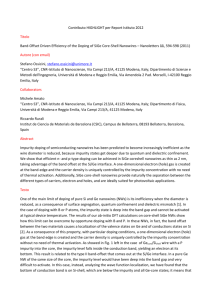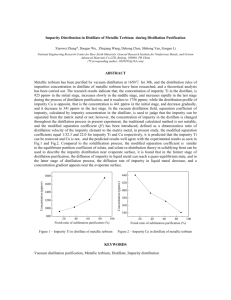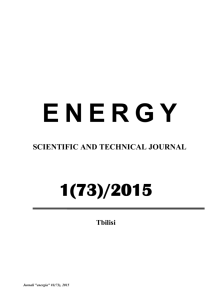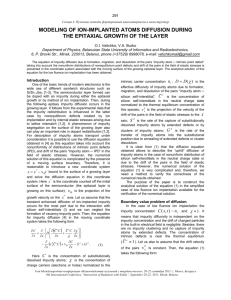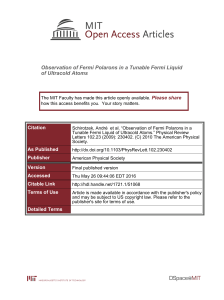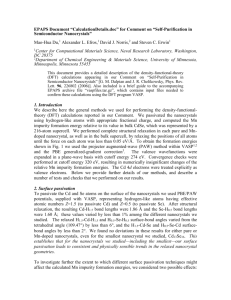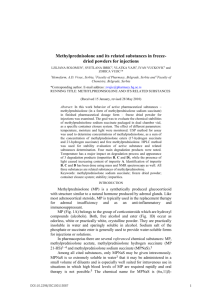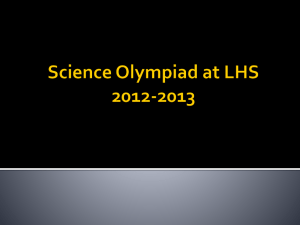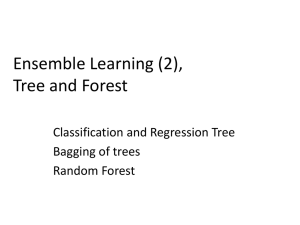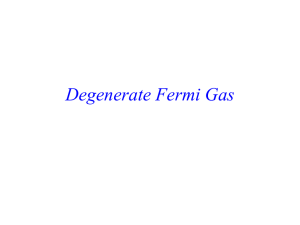Document
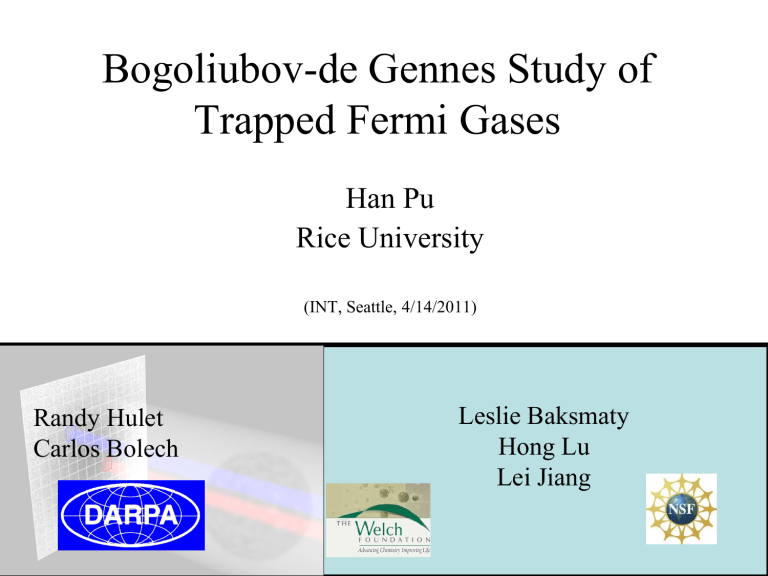
Bogoliubov-de Gennes Study of
Trapped Fermi Gases
Han Pu
Rice University
(INT, Seattle, 4/14/2011)
Randy Hulet
Carlos Bolech
Leslie Baksmaty
Hong Lu
Lei Jiang
Imbalanced Fermi mixtures
Fulde-Ferrel-Larkin-Ovchinnikov instability
• BCS Cooper pairs have zero momentum
• Population imbalance leads to finite-momentum pairs
• FFLO instability results in textured states
Experiments on spin-imbalanced Fermi gas
• Rice (Hulet Group)
– Science 311 , 503 (2006)
– PRL 97 , 190407 (2006)
– Nuclear Phys. A 790 , 88c (2007)
– J. Low. Temp. Phys. 148 , 323 (2007)
– Nature 467 , 567 (2010)
• ENS (Salomon Group)
– PRL 103 , 170402 (2009)
• MIT (Ketterle Group)
– Science 311 , 492 (2006)
– Nature 442 , 54 (2006)
– PRL 97 , 030401 (2006)
– Science 316 , 867 (2007)
– Nature 451 , 689 (2008)
Observation: Phase separation
MW. Zwierlein, A. Schirotzek, C.H. Schunck, and W, Ketterle:
Science 311, 492-496 (2006)
Superfluid core with polarized halo
Experimental results n
↑ n
↓ n
↑
n
↓
Hulet
High T
Ketterle Salomon
Low T
MIT/Paris data are consistent with Local Density Approximation (LDA)
Rice data (low T) strongly violates LDA.
Surface Tension
• Phase Coexistence -> Surface Tension
1 mm
60 m m
Aspect Ratio of
Cloud: 50:1
Aspect Ratio of
Superfluid: 5:1
Data: Hulet
Surface tension causes density distortion
Effects of surface tension more important in smaller sample.
Breakdown of LDA
P=0.14
P=0.53
P
N
N
N
N
LDA
LDA + surface tension
P=0.72
De Silva, Mueller, PRL 97, 070402 (2006)
Data points from Rice experiment.
Surface tension
2
2 m n s
4/3
Optimal value that fits data:
: 3 ~ 4
However, from microscopic theoretical calculation:
: 0.15
PRA 79, 063628 (2009)
Solving BdG equations
H
s 2
/ (2 )
( , )
1
2 m
r
2 2 r
z
2 2 z
Choose T and N
take initial guesses of m
,
r diagonalize the matrix
H s
* m
H
s m
adjust m
compute new until:
N
until the input and output m
,
r
Effect of trap anisotropy: N=200, P=0.4
2.5
2.0
1.5
1.0
0.5
Density along z-axis 2.0
1.5
1.0
0.5
0.2 0.4 0.6 0.8 1.0 1.2 1.4
z Z
TF 0.2 0.4 0.6 0.8 1.0 1.2 1.4
z Z
TF
2.0
1.5
1.0
0.5
2.5
2.0
1.5
1.0
0.5
Density along r-axis
2.0
1.5
1.0
0.5
0.2 0.4 0.6 0.8 1.0 1.2 1.4
r Z
TF 0.05 0.10 0.15 0.20 0.25 0.30
r Z
TF
2.0
1.5
1.0
0.5
0.2
0.4
0.6
0.8
1.0
z Z
TF
0.008
0.016
0.024
r Z
TF
1.0
0.8
0.6
0.4
0.2
Gap along z-axis
0.2 0.4 0.6 0.8 1.0 1.2 1.4
z Z
TF
AR=1
0.8
0.6
0.4
0.2
0.2 0.4 0.6 0.8 1.0 1.2 1.4
z Z
TF
AR=5
0.8
0.6
0.4
0.2
0.2
0.4
0.6
0.8
1.0
z Z
TF
AR=50
Quasi-1D system: N=200, AR=50
2.0
1.5
1.0
0.5
2.0
1.5
1.0
0.5
Density along z-axis
0.2
0.4
0.6
0.8
1.0
z
Z
TF
2.0
1.5
1.0
0.5
0.2
0.4
0.6
0.8
1.0
z Z
TF
2.0
1.5
1.0
0.5
0.2
0.4
0.6
0.8
1.0
z
Z
TF
Density along r-axis
0.008
0.016
0.024
r Z
TF
2.0
1.5
1.0
0.5
0.008
0.016
0.024
r Z
TF
2.0
1.5
1.0
0.5
0.008
0.016
0.024
r
Z
TF
0.8
0.6
0.4
0.2
Gap along z-axis
0.2
0.4
0.6
0.8
1.0
z
Z
TF
P=0.2
0.8
0.6
0.4
0.2
0.2
0.4
0.6
0.8
1.0
z
Z
TF
P=0.4
0.5
0.2
0.4
0.6
0.8
1.0
z Z
TF
P=0.7
BdG vs. LDA: N=200, AR=50, P=0.6
Gap along z-axis Gap along r-axis n
↑ n
↓ n
↑
n
↓
N ~200,000
Going to higher N
BdG equation is very nonlinear, it may support many stationary states.
Complicated energy landscape
For large N, starting from different initial configurations, the BdG solver may converge to different final states.
3 classes of states
NN
SF
LO
Density profiles (N=50,000)
SF LO
Increasing energy
NN
Upclose on the LO state n
↓ n
↑
Robustness of the density oscillation
Bulgac and Forbes, PRL 101 , 215301 (2008)
Pei, Dukelsky and Nazarewicz, PRA 82 , 021603 (2010)
FFLO in 1D homogeneous trapped
Orso, PRL (2007); Hu et al.
, PRL (2007)
Experiment in 1D (Hulet group)
Liao et al ., Nature 467 , 567 (2010)
3D
3D
Dimensional crossover: 3D – 1D t
X t
1D
1D
Model for single impurity in Fermi superfluidity
H
H
0
H imp
H imp
drU
( )
r
r
H
0 is BCS mean field Hamiltonian
U
( )
u
( ) for contact potential
U
( )
u
e
x a
2
2 for gaussian potential a
1
u
: impurity strength
: u
u
.
Magnetic impurity : u
u
.
BdG and T matrix methods
BdG method gives numerical results for single impurity in harmonic trap.
BdG solves self-consistently a set of coupled equations
Eu
( r )
( k ) u
( r )
i
y
v
( r )
U
( r ) u
( r ),
Ev
( r )
( k ) v
( r )
i
y
u
( r )
U
( r ) v
( r )
T-matrix gives exact solutions for localized contact impurity without trap.
G ( k , k ' ; w )
G
0
( k ; w )
( k
k ' )
G
0
( k ; w ) T ( w ) G
0
( k ' ; w )
Contact potential: T matrix only depends on energy.
Localized non-magnetic impurity in 1D trap
BdG results with impurity without impurity
T matrix results
Bound state occurs when T -1 (w)=0
E
0
( m mu
0
2
)
2
2 2
2 u
u
0
u
u
0
0 .
02 E
F
0 z
TF
Localized magnetic impurity u
u
u
0
0
BdG results
T matrix results
Bound state energy inside the gap
0
E
0
0
1
1
(
( u
0
N u
0
N
0
0
This bound state is below the bottom of quasiparticle band.
/ 2 )
2
/ 2 )
2
Density and gap profiles for localized magnetic impurity
Spin up
Spin down
What if we increase impurity width and strength ?
Magnetic impurity induced FFLO state
Impurity: Gaussian potential
Spin up
Spin down u
0 a
0 .
12
0 .
2 z
TF
,
0 .
4 ,
1 .
0 E
F z
TF
Magnetic impurity induced FFLO state (3D)
Conclusion
• Two component Fermi gas offers very rich physics.
• Effects of trapping confinement.
• Flexibility of atomic system provides opportunities of studying exotic pairing mechanisms.
References
• “Concomitant modulated superfluidity in polarized Fermi gases”,
Phys. Rev. A 83 023604 (2011)
• “Single impurity in ultracold Fermi superfluids”, arXiv:1010.3222
• “Bogoliuvob-de Gennes study of trapped spin-imbalanced unitary
Fermi gases”, arXiv:1104.2006
